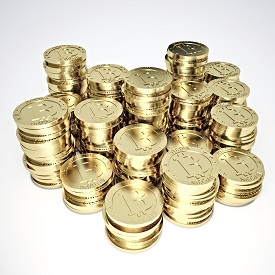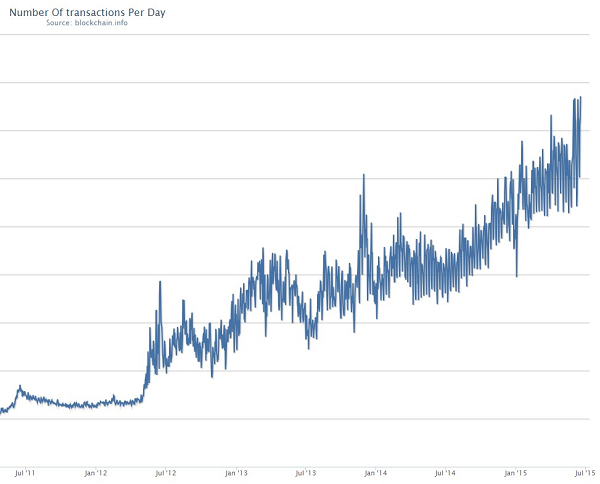 Satoshi Nakamoto released Version 0.1 of the application underlying Bitcoin on January 3, 2008. It wasn’t really software at that point in time; it didn’t have a user interface or even a DOS-like command line. To run it, you had to use Visual Studio on a Windows machine. Nevertheless, the functionality was “remarkably complete,” and the first online transaction took place six days later.
Satoshi Nakamoto released Version 0.1 of the application underlying Bitcoin on January 3, 2008. It wasn’t really software at that point in time; it didn’t have a user interface or even a DOS-like command line. To run it, you had to use Visual Studio on a Windows machine. Nevertheless, the functionality was “remarkably complete,” and the first online transaction took place six days later.
To make his project open-source, Nakamoto put it on SourceForge and asked other developers to suggest contributions to the core technology. Until mid-2010, Nakamoto controlled which of these suggestions would make it into the official version of the Bitcoin software. Then that responsibility passed to Gavin Andresen.
Andresen is an actual human and we’ll return to him in a moment. Nakamoto however, remains completely unknown. The New Yorker, Fast Company and Newsweek each conducted exhaustive investigations to find him, or her, or them. Each magazine identified different people. And every one of them denied being the Bitcoin inventor, leaving a great mystery at the center of the whole phenomenon.
Less mysterious is the fact that by 2013 Bitcoin’s usefulness as an online version of cash – allowing anyone to conduct business with anyone else in total anonymity and complete security – had established it as the currency of choice in certain marketplaces. You might, for example, use the Tor browser to access the Dark Net and purchase illicit goods on Silk Road. No one would have any idea who you were and they would have absolutely no way to figure it out. If you got the goods in the mail, and by chance the police showed up with them, your name wouldn’t be on the box, there’d be no record connecting you to it, and you could just shake your head and send them away. Most often, the box just arrived unimpeded.
Obviously, there weren’t many people doing such things and honest people didn’t even know they were possible. But Bitcoin had another attribute that would soon explode in the public imagination.
Value by Fiat or Value by Agreement?
 By 2013, the concept of “fiat currency” was all over the press because, in order to bailout Wall Street, the U.S. government printed an enormous amount of money (exactly how much depends on who you ask and how they answer, but it was somewhere between $700 billion and $12 trillion).
By 2013, the concept of “fiat currency” was all over the press because, in order to bailout Wall Street, the U.S. government printed an enormous amount of money (exactly how much depends on who you ask and how they answer, but it was somewhere between $700 billion and $12 trillion).
Some Americans wondered if the U.S. dollar would collapse because of this dilution, and what that might do to the country. Past governments that printed money to get out of a fix had endured catastrophes – the most commonly cited example was Weimar Germany in 1923. Their printing caused hyperinflation which caused massive upheaval which led directly to the ascension of Adolf Hitler.
Thus, Bitcoin hit the popular imagination at a particularly fortuitous time, because it was a state-less currency, backed only by the consensus of those who used it, and run by a globally distributed group of developers with no central authority. It even had the aura of the gold standard because only 21 million Bitcoin could ever come into existence – and no government could print a trillion more.
If the U.S. had trashed the dollar, then an independent form of cash might be something of a safe haven. A lot of people thought it was an interesting possibility. By the end of that year, the global market drove the value of a single Bitcoin from basically zero dollars to over $1,100. Everyone from the Republican National Caucus to Victoria’s Secret started accepting them.
That bubble burst a few months later. But Bitcoin didn’t collapse back to zero – which is why it’s still interesting two years later.
We Still Agree It Is Valuable
How could it be so resilient? If the Dark Web assigned it a value only in terms of Silk Road purchases, and then speculators inflated it to a ridiculous dollar amount only to leave suckers holding them in their wake, then how could there possibly still be a market to support its price – currently around $235?

The answer is the blockchain, which is such an ingenious invention that it’s attracted the attention of international finance.
From the outset, the Bitcoin system was developed to be “trustless” – every transaction had to take place in an environment where everyone and anyone would cheat if they could. The blockchain makes it so they can’t. It records every single transaction of every single Bitcoin. (Or part of a Bitcoin – the smallest unit of exchange is the Satoshi, 1/100,000,000 Bitcoin.) It starts with a “genesis block” paid to a developer for increments of work done encrypting and authorizing transactions. Each transaction adds a block to it. The whole thing is encrypted and each step builds upon the previous one in such a way that it would take thousands of supercomputers millions of years to counterfeit just one.
(That doesn’t mean Bitcoin can’t be stolen. They are held in digital wallets, and the key that opens that wallet (a very long string of apparently random characters) can be stolen. Every Bitcoin blog, online forum, and aficionado will tell you to keep the key on a flash drive that’s never connected to the Internet, which is the only way you can be sure it’s safe. You may have heard of the massive theft that befell Mt. Gox, an exchange in Japan, last year. That happened because customers let Mt. Gox manage their keys.)
Since 2008, there hasn’t been a single instance of anyone fooling or hacking the blockchain itself, and that’s what interests global financial institutions.
So Gavin Andresen and others established the Bitcoin Foundation to give the international consortium of developers – most of whom have extreme anti-establishment beliefs – some semblance of organization.
And We Agree It’s Inviolable
Since Andresen has been a lead developer from the beginning, the Foundation made some small progress towards becoming the spokesperson for the Bitcoin movement. The only problem is this: the system relies upon developers all over the world running the same Bitcoin software on their servers.
If you want to change something, all of the developers have to go along with it. If that change is a small improvement to the code, then no problem. But if that change involves even the most trivial shadow of a concept that might someday give one shred of authority to any “institution,” its dead in the water. The developers won’t implement it, the guy who introduced it will be excluded, and there’s absolutely nothing anyone can do about it.
Due to this hostility towards authority of any kind, and to some internal problems, the Foundation has had a hard time funding itself. Andresen and a few other developers, working more than full time, were originally compensated by the Foundation, but that didn’t last.
The Massachusetts Institute of Technology stepped in to help, establishing a Digital Currency Initiative in its famous Media Lab.
Note that it’s not a “Bitcoin Initiative.” When announcing its creation the director, Brian Forde, emphasized the blockchain: “This new system lets people transfer money without a bank. Write simple, enforceable contracts without a lawyer. Or, turn physical items like real estate or tickets to the ball game or concert into digital assets that can be sold with low to no transaction fees.”
He believes the technology will be as disruptive as the Internet has been, and he’s not alone.
For example, the NYSE, USAA Bank, and former Citigroup CEO Vikram Pandit own stakes in Coinbase, a Bitcoin exchange and wallet provider. Former Managing Director and Global Head of JP Morgan Chase’s $3.4 billion Transaction Services business (and Deutsche Bank alumnus) Paul Chase recently became the Chief Financial Officer for Circle, one of several bank-like service providers cropping up. And the gigantic Swiss banking behemoth, UBS, opened a blockchain research lab in London.
It’s possible that Bitcoin will become an internationally common form of payment, and it’s likely that blockchain technology will influence some transactions. But for the time being, it’s probably more likely that you’ll have Satoshi Nakamoto as a customer than that you’ll need to concern yourself with Bitcoin or the blockchain.
You should, however, concern yourself with the demand underlying both. People want secure payments, they want privacy, and they fear hackers – be they criminals or the government. Only one form of payment circumvents digital payment processing as cleanly as Bitcoin, and that’s paper checks. Believe it or not, the antithesis of the Internet Age remains the single most secure form of payment. Learn how to get your revenue from them guaranteed with check guarantee.



